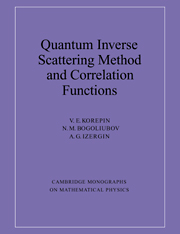Final Conclusion
Published online by Cambridge University Press: 04 August 2010
Summary
We have explained the theory of exactly solvable models on both the quantum and classical levels. We hope that the reader appreciates the beauty and perfection of the Bethe Ansatz. The theory of completely integrable nonlinear partial differential equations plays an equally important role in the book. It is deeply related to the Bethe Ansatz. We hope that our book can be used for further development of the theory of exactly solvable models (we think that the interested reader can find problems to work out in our book). Our book does not close the theory of the Bethe Ansatz; it opens new possibilities for further development.
We have explained how to construct eigenfunctions of the Hamiltonian and how to describe the ground state and its excitations. We have also evaluated dispersion curves and scattering matrices for the excitations. The thermodynamics of exactly solvable models is explained in this book in all the details, including the evaluation of temperature correlation functions (even if they depend on real time). The problem of the evaluation of correlation functions (for Bethe Ansatz solvable models) is solved in our book, using the example of the one-dimensional Bose gas (quantum nonlinear Schrödinger equation). It was done using the ideas of the inverse scattering method (the Lax representation, the Riemann-Hilbert problem, the Gel'fand-Levitan-Marchenko equation, etc.). We would like also to emphasize that all other Bethe Ansatz solvable models are constructed in a similar way.
- Type
- Chapter
- Information
- Quantum Inverse Scattering Method and Correlation Functions , pp. 518 - 519Publisher: Cambridge University PressPrint publication year: 1993

